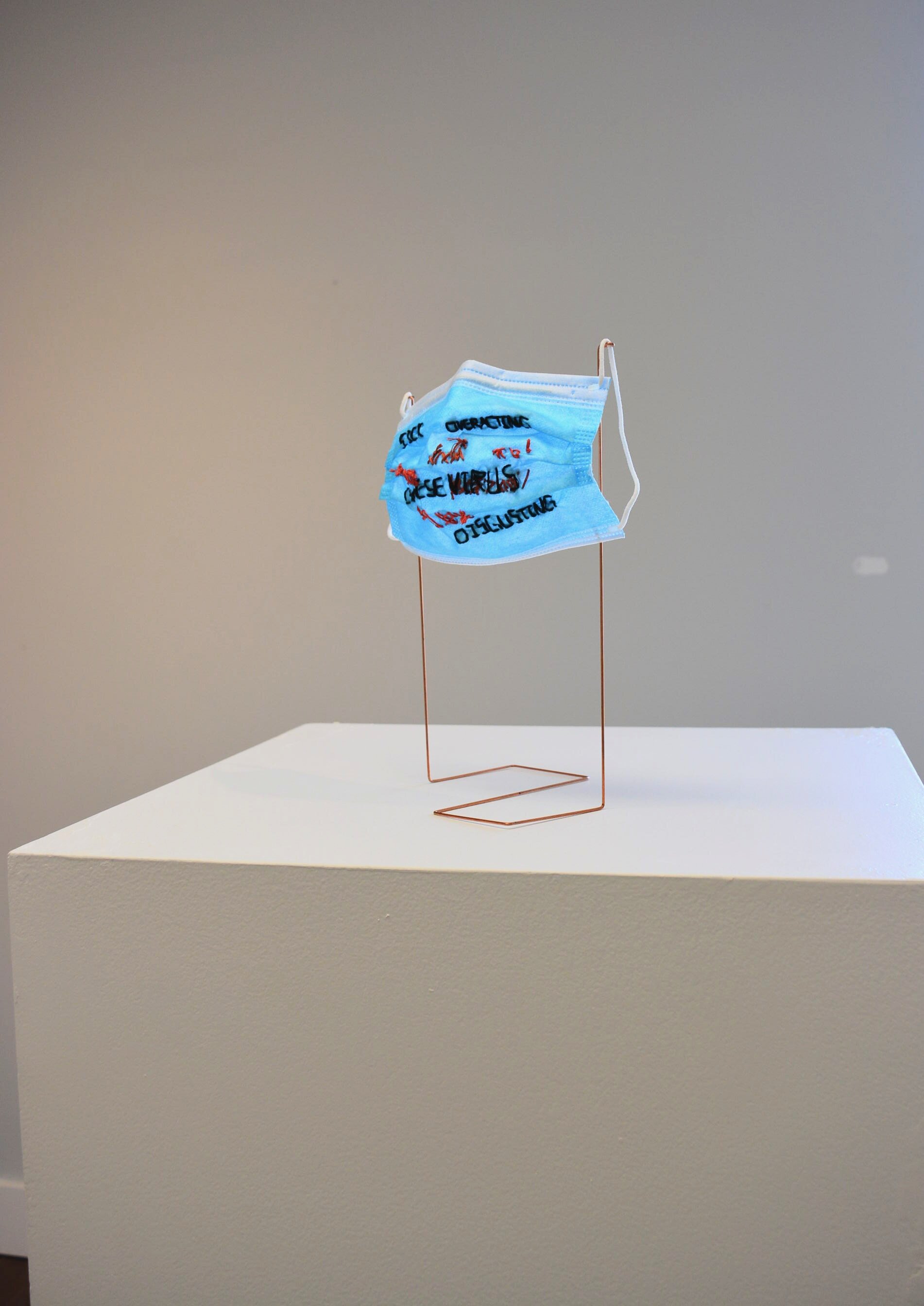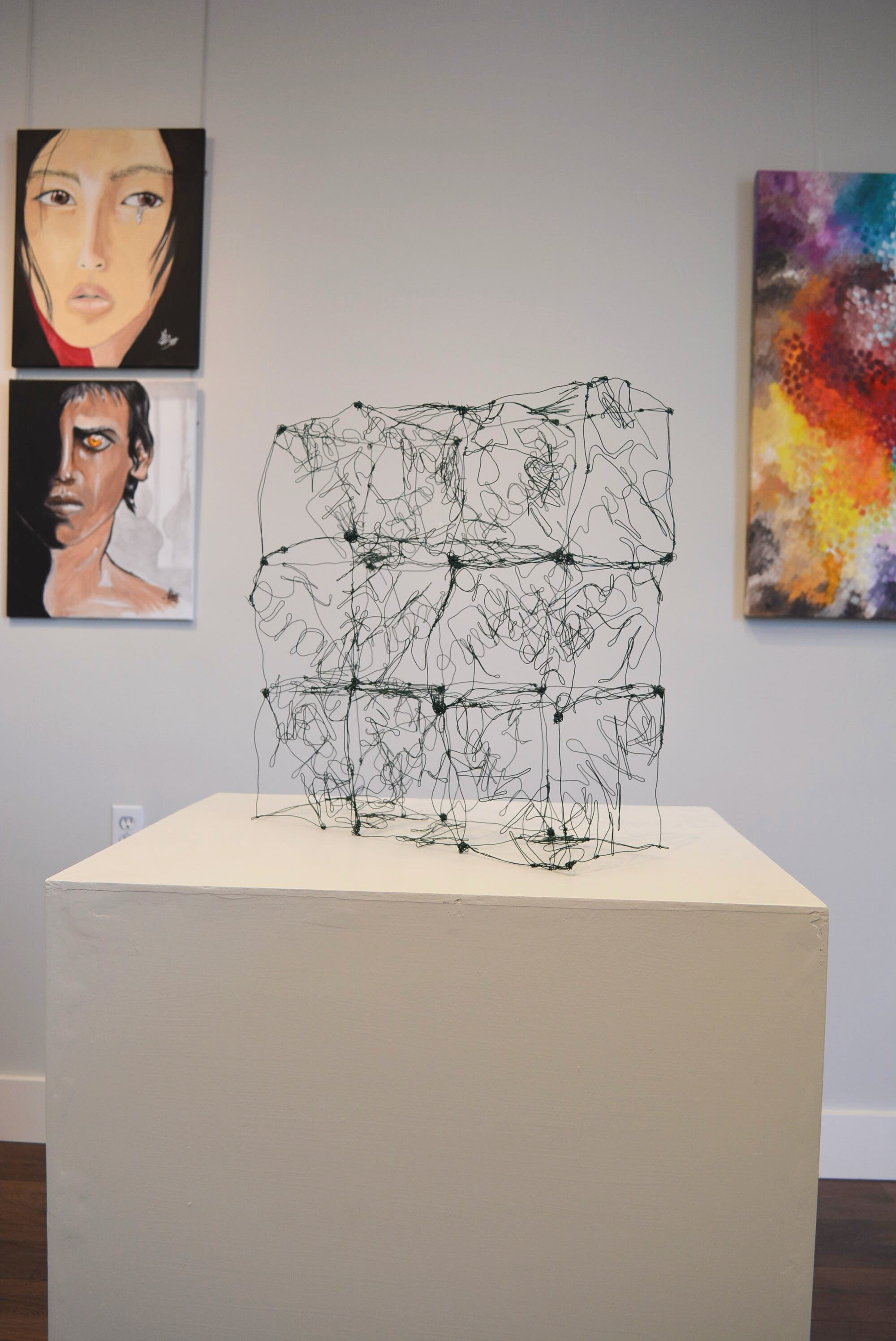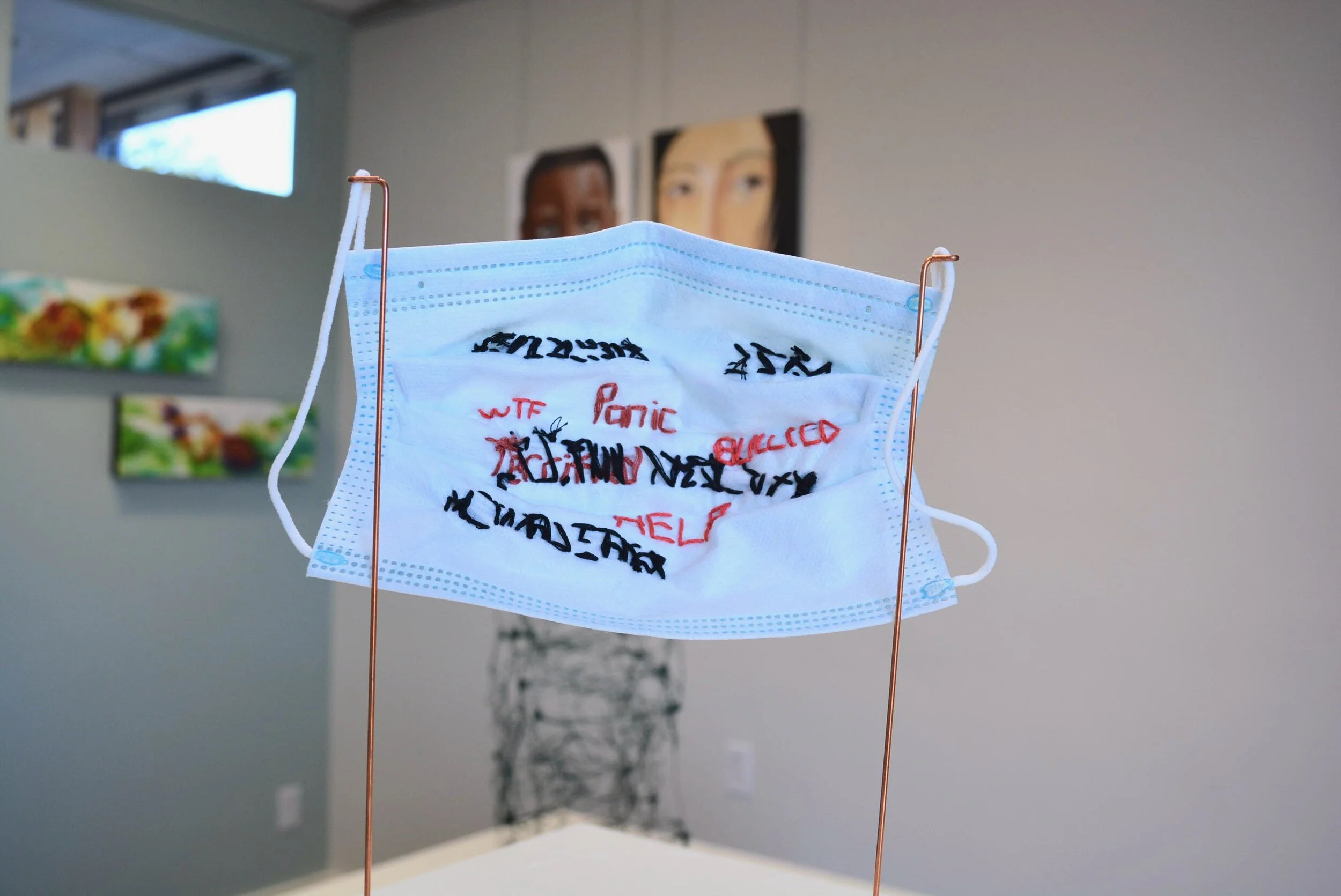Cai Leting
Cai Leting is a Chinese artist who is currently studying Visual Arts at the University of Victoria on the traditional lands of the Lekwungen and W̱SÁNEĆ Peoples. Cai is originally from Shanghai, China, and she has lived in Victoria since 2015. Cai is a sculptor and a conceptual artist. She believes that Arts will always find a way to make a difference to the world because every form of Arts is a vessel for human civilization and it constantly rolls forward.
Cai is familiar with needle felting, crocheting, weaving, and welding. She is very devoted to material innovations. For the past two years, Cai has been focusing on challenging the stereotypical relationship between domestic craft and institutional arts as a reflection on the mistreatments of feminine art in the male dominated art world.
-

Masking 口罩
9’’ x 4’’ x 10’’
Multimedia
$2,020.00
To purchase, contact the artistMasking is an embroidered textile artwork that condemns the Anti-Asian Racism during the first wave of COVID-19 and its lasting scarring to people, culture, and society.
Wearer's insecure inner thoughts and brassy outer judgements were embroidered over each other as different culture values collided on both sides of the mask.
The means of embroidery was deliberately chosen to mimic the painful experience in racism as sharp needles poking through the soft material of the mask with irreversible damages leaving behind.
-

Lateral Support 纵向支撑
18’’ x 6’’ x 18’’
Floral Wire
$150.00
To purchase, contact the artistLateral Support is a conceptual artwork that aims to combat and acknowledge Lateral Violence between minority groups in racism.
It is a wire sculpture that applies triggers in lateral bullies, such as difference (差异), culture (文化), and hurt (伤害), as diagonal supporting bracings to demonstrate the strength of a lateral support system in physics. It is a play of definitions and concepts to show the power of lateral support in contrast to the destruction in lateral violence.
The sculpture is made with floral wire, which is a delicate material that is meant to guide and support the growing of blossoms.

Lateral Support 纵向支撑 | 18’’ x 6’’ x 18’’ | Floral Wire | $150.00


Masking 口罩 | 9’’ x 4’’ x 10’’ | Multimedia | $2,020.00
Hear Cai’s Story
Each contributing Colour Theory artist created an original essay or story to accompany their visual artwork. You can listen to the audio or scroll down to read.
Nomadic Belongingness
Nomadic Belongingness | A Story about Cultural Racism, Self-Location, and Lateral Violence
I have been spending a lot of time wondering who I am and how I self-locate in my existence. I am biologically Asian, my nationality is Chinese, I am a bisexual woman, but how do I belong beyond social construct?
I was born in Shanghai, China, a city that was highly influenced by Western culture as it was forced to open as treaty ports to European trade after the First Opium War. I studied at a Canadian high school in China before I moved to Victoria. Then I had another 6 years of Western postgraduate education.
I didn’t feel like I was exposed to enough Chinese traditions during my 9 years of examination-oriented education to bond with my Chinese identity, and yet I didn’t think I belonged to any Western society because of the lack of knowledge and “common senses” growing up in a Western environment. I was culturally modified to fit in the trend of globalization with a bit of everything.
My culture inconclusiveness seemed fine when I was growing up under the same cultural shield with all the other globalized kids around, but it later on revealed that my lack of ethnic settlement was problematic especially during the long and lonely longing in the time of COVID-19 quarantine when I tried to find my self-belongingness over the tsunami of nostalgia, anti-Asian prejudice and cultural racism.
For my 6 years living in Canada, I have experienced racism and discrimination here and there through my appearance, my gender, my education, and more. Sometimes people just couldn’t believe that I am a well-educated Chinese woman, who has good manners, and says NO to things. In 2020, the outbreak of Coronavirus started the Asian Hate all over the world especially in the west. Prejudice and name-calling were put upon Asians as the virus was first discovered in Wuhan, China. Coronavirus was referred to as the ‘Chinese Virus’ in some media. And Asians, particularly Chinese people, were blamed with hateful accusations. And by this extraordinary period of time, I encountered my first major cultural racist event as an Asian during the first wave of COVID-19.
Before the BC health ministry recommended medical masks as an efficient tool for preventing Coronavirus, masks-wearing was not suggested or “accepted” because the WHO referred to such behaviour as an emergency solution only when you were sick. However, Chinese health authorities along with my family held another opinion that everyone should wear a medical mask in public since it was one of the most efficient ways to stop the spreading of the virus as one’s own social responsibility. With two media quarrelling about their opposite social practices and cultural beliefs aggressively around me, I got trapped in a limbo of values. It was either wear a mask and face discrimination, or dodging prejudice but living in panic that people might pass sickness onto me. My friends and I were so scared to even just go out to the grocery stores because of all the resentful judging gazes that were yelling to us about how we should not co-exist for who we are and what we believe.
One after another, friends decided to go back to China permanently and left their lives in Canada behind to escape from this social virus of racism. With such a divide between my culture values and my social belongingness, I started to wonder where and how did I actually fit into my so-called community physically and culturally?
With the anti-Asian racism striking all over the world, cultural racism didn’t just stop between different biological races; it provoked lateral violence in between different Asian groups. When the majority of racists continued targeting Asian people for pandemic, Asians with different nationalities started to accuse Chinese people for dragging them down to this Anti-Asian racism vortex. Hateful messages were blooming on the internet. People were making t-shirts that specifically said directional blames such as “I am not Chinese” or other abusive words to demonstrate their alliance with the majority of racists in order to avoid attacks on themselves. However, internalized segregation never truly protects any minority groups from hate and prejudice but reinforces more damage to the situation because racism was never personal. What we need is “lateral support” not lateral violence.
It was a dark period of time for all humans. Although I got so painfully shut out from the western culture and society, my sense of identity and belongingness unexpectedly emerged clear for the first time.
At the forefront of the pandemic and the anti-Asian racism, I was feeling so hurt, confused, and unheard from the media and my multicultural intimate relationship at the time so I decided to make an artwork to the public to share how the racist events had emphasized the torment of the pandemic. The artwork was an embroidered medical mask with voices that were collected from social media, my peers, and my personal experiences about how it felt as Asians and the only ones who wore masks out in public at the time.
I was very scared about having this work out on social media because it was controversial and I was never a confrontational person in real life, but I was so repressed that my anger eventually overcame my vulnerability for me to build up courage to share my insights, as an Asian, to condemn this craziness and unfairness and to support my people.
I didn’t expect much feedback; nor should I say that I was scared of any feedback because I wasn’t sure if I was ready for internet hatreds, but then something wonderful happened.
Immediately after I posted my work and insights on Instagram, many of my international peers and friends from China reached out to me saying how much they were touched and appreciative that I came forward to speak up for “us”. People with zero connections before were confronting and comforting each other with their vulnerabilities through sharing experiences and wounds in the comment section. It was finally a safe place to express and unload. People thanked me for supporting them with the defence that they weren’t able to unveil but they didn’t realize that it was actually them, their backing and strength, supported me and rescued me from my withering standing of self-existence.
Not until that very moment did I realize that I might be nomadic, but I was never alone.
I had a family of people who shared the same pain and confusion with me the whole time. We might be lost in the drizzling realities of differences but we will find each other as long as we keep trying.
I belong.
I belong with justice.
I belong with my belief in love and kindness.
I belong with differences.
And I will always celebrate the diversity of it.
